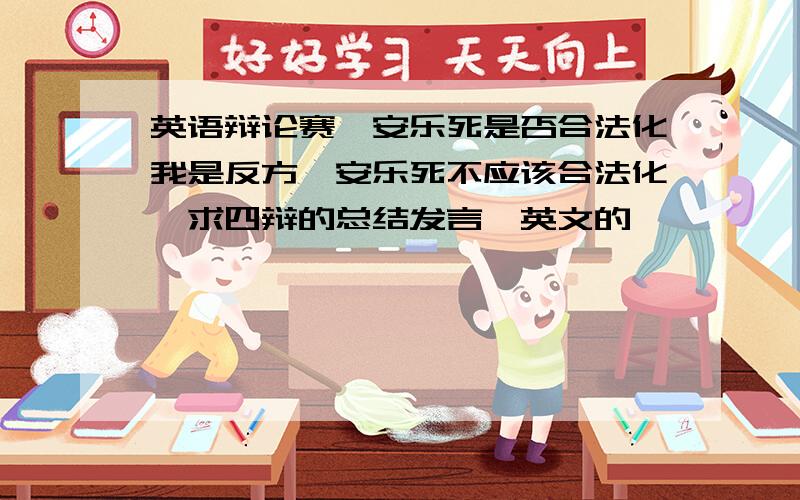英语辩论赛,安乐死是否合法化我是反方,安乐死不应该合法化,求四辩的总结发言,英文的
来源:学生作业帮助网 编辑:作业帮 时间:2024/04/20 19:51:43

英语辩论赛,安乐死是否合法化我是反方,安乐死不应该合法化,求四辩的总结发言,英文的
英语辩论赛,安乐死是否合法化
我是反方,安乐死不应该合法化,求四辩的总结发言,英文的
英语辩论赛,安乐死是否合法化我是反方,安乐死不应该合法化,求四辩的总结发言,英文的
给您一点参考资料:
Those who are against euthanasia state that euthanasia is morally andethically wrong, but this is not the end of the argument. The argument alsoincludes that euthanasia is not necessary when palliative, a medical specialtyfocused solely on pain, stress, and symptom relief, is so advanced (Center toAdvance Palliative Care, 2009). In most cases, the desire to die or suicidalthoughts have been shown to be clinical depression which is treatable. Attemptsto legalize euthanasia did not occur until the 20th Century, and history doesnot provide an adequate example to why euthanasia should be legalized. Theargument against euthanasia includes the slippery slope, that once the door ofeuthanasia is open, it becomes increasingly easier for ethics and laws to beedited, changed, and "updated" to become increasingly liberal indefinition and application. By definition, euthanasia is illegal and immoral.Euthanasia is the ending of a person's life and presents a threat to all peoplewith disabilities, chronic physical and mental illnesses, the elderly, andother vulnerable portions of the population (Euthanasia Prevention Coalition,2006).
One of the misconceptions put forth by the "right to die"proponents is that those against euthanasia and assisted suicide believe that aterminal patient must be kept alive by any means available, which is not true.The Catholic Church (1994, 1997), states that: "Discontinuing medicalprocedures that are burdensome, dangerous, extraordinary, or disproportionateto the expected outcome can be legitimate...the refusal of"over-zealous" treatment. Here one does not will to cause death;one's inability to impede it [death] is merely accepted. The decisionsshould be made by the patient if he is competent and able or, if not, by thoselegally entitled to act for the patient...Even if death is thought imminent,the ordinary care owed to a sick person cannot be legitimately interrupted. Theuse of painkillers to alleviate the sufferings of the dying, even at the riskof shortening their days, can be morally in conformity with human dignity ifdeath is not willed as either an end or a means, but only foreseen and toleratedas inevitable. Palliative care is a special form of disinterested charity. Assuch it should be encouraged. "
Some supporters of euthanasia will make the claim that the terminally illare a burden to their family or to society. Illnesses such as quadriplegia,Parkinson's, Alzheimer's, and other physical and mental disabilities do createemotional and financial burdens, because the person is dependent on others forcare, and for now, these "burdens to society" are safe in ourcountry. The Netherlandsare already known for having legalized euthanasia. The practice has beenquietly expanding from 'just' the terminally ill and elderly to includeinfants. Worse yet, Dutch euthanasia rules do not require the patient to beterminally ill, but judged only on whether or not a "livable life" isattainable. The guidelines for making this determination are known as theGroningen Protocol. According to Smith, (2006),
The subsequently compiled Groningen Protocol--which is expected to form thebasis for the official approval of Dutch pediatric euthanasia--similarlycreated categories of killable babies: infants "with no chance ofsurvival," infants with a "poor prognosis and are dependent onintensive care," and "infants with a hopeless prognosis,"including those "not depending on intensive medical treatment but for whoma very poor quality of life... is predicted." In other words, infanteuthanasia is not restricted to dying babies but can be based on predictedserious disability.
Proponents for human euthanasia claim that restrictions, laws, andgovernment oversight will provide the necessary guidelines to preventeuthanasia from being abused; however, one look at euthanasia in the Netherlandsproves that this is far from the truth. Euthanasia has been legalized for morethan a decade in the Netherlands, and according to Hendin (2000), doctors therehave become complacent about the use of euthanasia, and numerous incidents arecited in which euthanasia was used against the patient's will.
Being alive is not equivalent to living: on this premise, both sides of thedebate about euthanasia can agree; however, the right to decide when deathtrumps life is not man's decision to make. The physicians in the Netherlands aretaking liberties and playing God with the lives of patients, often without thepatient's knowledge or consent. The example set forth by the Netherlandsclearly demonstrates that euthanasia does not provide balance to the medicaladvancements that can postpone death via life sustaining machines; instead, ittips the balance in favor of physicians, nurses, and families, who are tired ofcaring for the patient, believe the patient's life is of no value, and in whichpatients are given no choice. The Netherlands is the example of why eventhough euthanasia may be legal, sanctioned by legislators, and performed bydoctors, it can, is, and will continue to be abused.